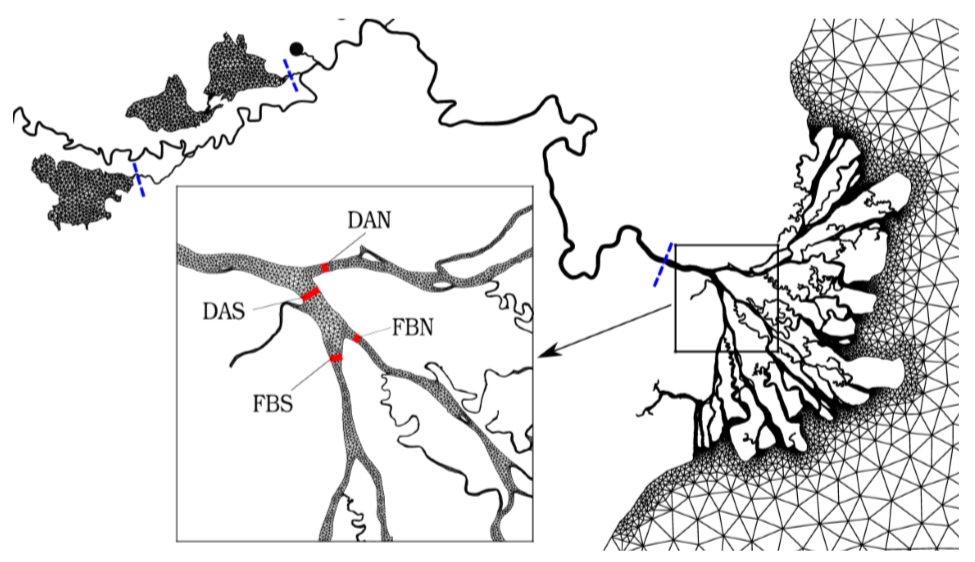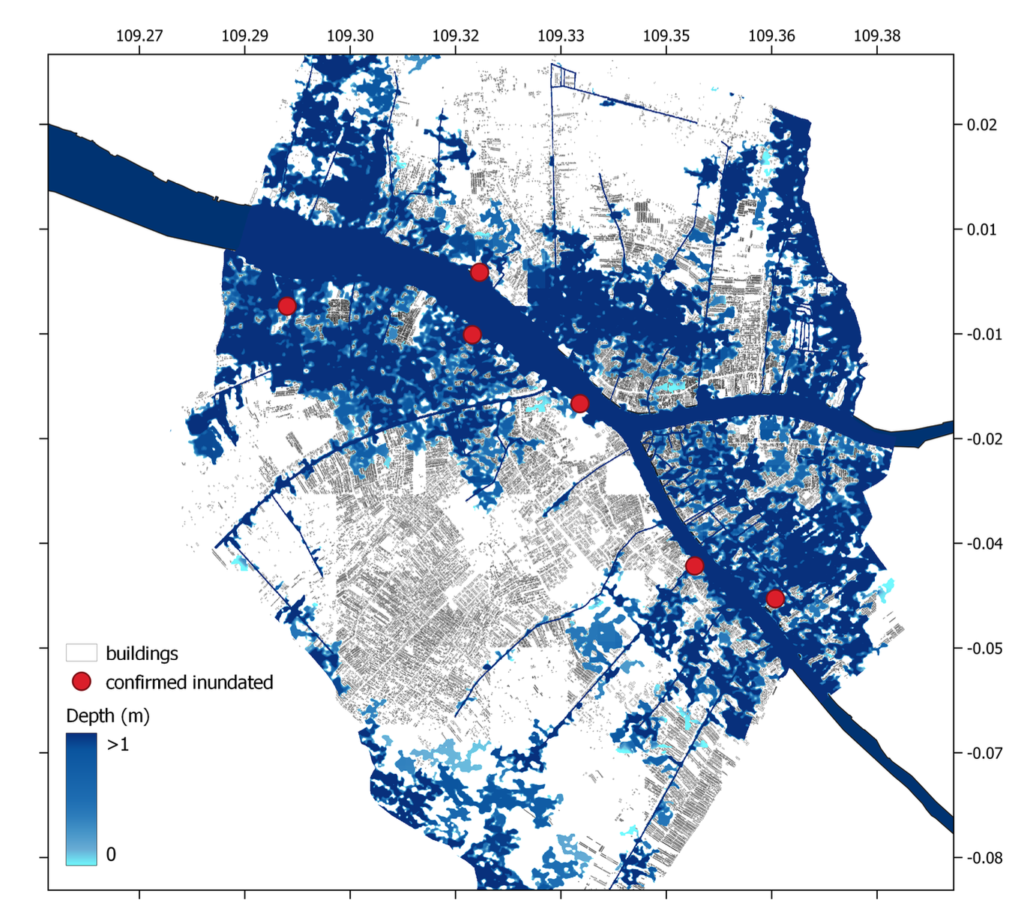We have been applying SLIM in Indonesia for more than 10 years. Our first main application was the Mahakam river-lake-delta system. The Mahakam is a 980-km-long tropical river in the East Kalimantan province (Borneo Island) that flows into the Makassar Strait through a complex delta. We used SLIM2D to simulate the hydrodynamics of the Makassar Strait, the Mahakam Delta and the three lakes upstream of the delta. The hydrodynamics of the rivers, from the upstream limit of the delta to the lakes and further upstream, were simulated with SLIM1D. The model has been thoroughly validated with in-situ water elevation, flow velocity, and water discharge observations. The hydrodynamic model outputs were then used to simulate sediment transport and water age through the river-lake-delta system.
Overview of the unstructured mesh discretization of the Mahakam river-lake-delta-sea system. Another area of application of SLIM in Indonesia is the Kapuas river delta, located in the western part of Borneo Island. The Kapuas is a 1140-km-long river that flows into the Karimata Strait. We studied the hydrodynamics of the Kapuas Kecil branch that merges with the Landak river in the city of Pontianak. We were particularly interested in assessing the compound flooding risk in the river delta and in the city of Pontianak arising from the interplay between storm surges, tides and the river discharge. We considered a model setup that included the floodplains in the river delta as well as the entire city of Pontianak to simulate the inundation dynamics. This model setup was subsequently used to train a machine learning algorithm to reduce the computational cost of flooding predictions.
Simulated inundation map in the city of Pontaniak during the flood event on 29 December 2018 at 06:00 UTC. Finally, we are currently applying SLIM to the Wakatobi National Park (WNP), in the Coral Triangle, to estimate coral connectivity and identify reefs best suited for conservation and restoration projects. We assessed the interannual and interspecific variability of different connectivity indicators and identified sub-reefs that were consistently ranked high for all eight years and for both species. We found that both El Niño and La Niña events lead to a significant increase in larval exchanges across the WNP for both species. Overall, our results suggest that, under the current WNP zoning, there is limited overlap between marine protected zones and the reefs identified as best candidates for reef protection and restoration based on larval connectivity.
External collaborators
Prof. Ton Hoitink (Wageningen University), Prof. Jamaluddin Jompa (Hasanuddin Universtiy) and Dr Joko Sampurno (Universitas Tanjungpura)
To learn more…
778265
indonesia
items
1
0
date
desc
4823
https://www.slim-ocean.be/wp-content/plugins/zotpress/
%7B%22status%22%3A%22success%22%2C%22updateneeded%22%3Afalse%2C%22instance%22%3A%22zotpress-fcd7add1a6a8d6023843e3cd544b8dd6%22%2C%22meta%22%3A%7B%22request_last%22%3A0%2C%22request_next%22%3A0%2C%22used_cache%22%3Atrue%7D%2C%22data%22%3A%5B%7B%22key%22%3A%22M6RKKS6A%22%2C%22library%22%3A%7B%22id%22%3A778265%7D%2C%22meta%22%3A%7B%22creatorSummary%22%3A%22Sampurno%20et%20al.%22%2C%22parsedDate%22%3A%222023-01-01%22%2C%22numChildren%22%3A1%7D%2C%22bib%22%3A%22%3Cdiv%20class%3D%5C%22csl-bib-body%5C%22%20style%3D%5C%22line-height%3A%202%3B%20padding-left%3A%201em%3B%20text-indent%3A-1em%3B%5C%22%3E%5Cn%20%20%3Cdiv%20class%3D%5C%22csl-entry%5C%22%3ESampurno%2C%20J.%2C%20Ardianto%2C%20R.%2C%20%26amp%3B%20Hanert%2C%20E.%20%282023%29.%20Integrated%20machine%20learning%20and%20GIS-based%20bathtub%20models%20to%20assess%20the%20future%20flood%20risk%20in%20the%20Kapuas%20River%20Delta%2C%20Indonesia.%20%3Ci%3EJournal%20of%20Hydroinformatics%3C%5C%2Fi%3E%2C%20%3Ci%3E25%3C%5C%2Fi%3E%281%29%2C%20113%26%23x2013%3B125.%20%3Ca%20href%3D%27https%3A%5C%2F%5C%2Fdoi.org%5C%2F10.2166%5C%2Fhydro.2022.106%27%3Ehttps%3A%5C%2F%5C%2Fdoi.org%5C%2F10.2166%5C%2Fhydro.2022.106%3C%5C%2Fa%3E%3C%5C%2Fdiv%3E%5Cn%3C%5C%2Fdiv%3E%22%2C%22data%22%3A%7B%22itemType%22%3A%22journalArticle%22%2C%22title%22%3A%22Integrated%20machine%20learning%20and%20GIS-based%20bathtub%20models%20to%20assess%20the%20future%20flood%20risk%20in%20the%20Kapuas%20River%20Delta%2C%20Indonesia%22%2C%22creators%22%3A%5B%7B%22creatorType%22%3A%22author%22%2C%22firstName%22%3A%22Joko%22%2C%22lastName%22%3A%22Sampurno%22%7D%2C%7B%22creatorType%22%3A%22author%22%2C%22firstName%22%3A%22Randy%22%2C%22lastName%22%3A%22Ardianto%22%7D%2C%7B%22creatorType%22%3A%22author%22%2C%22firstName%22%3A%22Emmanuel%22%2C%22lastName%22%3A%22Hanert%22%7D%5D%2C%22abstractNote%22%3A%22As%20more%20and%20more%20people%20live%20near%20the%20sea%2C%20future%20%5Cufb02ood%20risk%20must%20be%20properly%20assessed%20for%20sustainable%20urban%20planning%20and%20coastal%20protection.%20However%2C%20this%20is%20rarely%20the%20case%20in%20developing%20countries%20where%20there%20is%20a%20lack%20of%20both%20in-situ%20data%20collection%20and%20forecasting%20tools.%20Here%2C%20we%20consider%20the%20case%20of%20the%20Kapuas%20River%20Delta%20%28KRD%29%2C%20a%20data-scarce%20delta%20on%20the%20west%20coast%20of%20Borneo%20Island%2C%20Indonesia.%20We%20assessed%20future%20%5Cufb02ood%20risk%20under%20three%20climate%20change%20scenarios%20%28RCP2.6%2C%20RCP4.5%2C%20and%20RCP8.5%29.%20We%20combined%20the%20multiple%20linear%20regression%20and%20the%20GIS-based%20bathtub%20inundation%20models%20to%20assess%20the%20future%20%5Cufb02ood%20risk.%20The%20former%20model%20was%20implemented%20to%20model%20the%20river%5Cu2019s%20water-level%20dynamics%20in%20the%20KRD%2C%20particularly%20in%20Pontianak%2C%20under%20the%20in%5Cufb02uence%20of%20rainfall%20changes%2C%20surface%20wind%20changes%2C%20and%20sea-level%20rise.%20The%20later%20model%20created%20%5Cufb02ood%20maps%20with%20inundated%20areas%20under%20a%20100-year%20%5Cufb02ood%20scenario%2C%20representing%20Pontianak%5Cu2019s%20current%20and%20future%20%5Cufb02ood%20extent.%20We%20found%20that%20about%206.4%25%5Cu201311.9%25%20more%20buildings%20and%20about%206.8%25%5Cu201312.7%25%20more%20roads%20will%20be%20impacted%20by%20a%20100-year%20%5Cufb02ood%20in%202100.%20Our%20assessment%20guides%20the%20local%20water%20manager%20in%20preparing%20adequate%20%5Cufb02ood%20mitigation%20strategies.%22%2C%22date%22%3A%222023-01-01%22%2C%22language%22%3A%22en%22%2C%22DOI%22%3A%2210.2166%5C%2Fhydro.2022.106%22%2C%22ISSN%22%3A%221464-7141%2C%201465-1734%22%2C%22url%22%3A%22https%3A%5C%2F%5C%2Fiwaponline.com%5C%2Fjh%5C%2Farticle%5C%2F25%5C%2F1%5C%2F113%5C%2F92197%5C%2FIntegrated-machine-learning-and-GIS-based-bathtub%22%2C%22collections%22%3A%5B%22GJSQZPDC%22%5D%2C%22dateModified%22%3A%222023-02-02T08%3A09%3A41Z%22%7D%7D%2C%7B%22key%22%3A%22ZLWJG9LY%22%2C%22library%22%3A%7B%22id%22%3A778265%7D%2C%22meta%22%3A%7B%22creatorSummary%22%3A%22Sampurno%20et%20al.%22%2C%22parsedDate%22%3A%222022-08-01%22%2C%22numChildren%22%3A1%7D%2C%22bib%22%3A%22%3Cdiv%20class%3D%5C%22csl-bib-body%5C%22%20style%3D%5C%22line-height%3A%202%3B%20padding-left%3A%201em%3B%20text-indent%3A-1em%3B%5C%22%3E%5Cn%20%20%3Cdiv%20class%3D%5C%22csl-entry%5C%22%3ESampurno%2C%20J.%2C%20Vallaeys%2C%20V.%2C%20Ardianto%2C%20R.%2C%20%26amp%3B%20Hanert%2C%20E.%20%282022%29.%20Integrated%20hydrodynamic%20and%20machine%20learning%20models%20for%20compound%20flooding%20prediction%20in%20a%20data-scarce%20estuarine%20delta.%20%3Ci%3ENonlinear%20Processes%20in%20Geophysics%3C%5C%2Fi%3E%2C%20%3Ci%3E29%3C%5C%2Fi%3E%283%29%2C%20301%26%23x2013%3B315.%20%3Ca%20href%3D%27https%3A%5C%2F%5C%2Fdoi.org%5C%2F10.5194%5C%2Fnpg-29-301-2022%27%3Ehttps%3A%5C%2F%5C%2Fdoi.org%5C%2F10.5194%5C%2Fnpg-29-301-2022%3C%5C%2Fa%3E%3C%5C%2Fdiv%3E%5Cn%3C%5C%2Fdiv%3E%22%2C%22data%22%3A%7B%22itemType%22%3A%22journalArticle%22%2C%22title%22%3A%22Integrated%20hydrodynamic%20and%20machine%20learning%20models%20for%20compound%20flooding%20prediction%20in%20a%20data-scarce%20estuarine%20delta%22%2C%22creators%22%3A%5B%7B%22creatorType%22%3A%22author%22%2C%22firstName%22%3A%22Joko%22%2C%22lastName%22%3A%22Sampurno%22%7D%2C%7B%22creatorType%22%3A%22author%22%2C%22firstName%22%3A%22Valentin%22%2C%22lastName%22%3A%22Vallaeys%22%7D%2C%7B%22creatorType%22%3A%22author%22%2C%22firstName%22%3A%22Randy%22%2C%22lastName%22%3A%22Ardianto%22%7D%2C%7B%22creatorType%22%3A%22author%22%2C%22firstName%22%3A%22Emmanuel%22%2C%22lastName%22%3A%22Hanert%22%7D%5D%2C%22abstractNote%22%3A%22Flood%20forecasting%20based%20on%20hydrodynamic%20modeling%20is%20an%20essential%20non-structural%20measure%20against%20compound%20%5Cufb02ooding%20across%20the%20globe.%20With%20the%20risk%20increasing%20under%20climate%20change%2C%20all%20coastal%20areas%20are%20now%20in%20need%20of%20%5Cufb02ood%20risk%20management%20strategies.%20Unfortunately%2C%20for%20local%20water%20management%20agencies%20in%20developing%20countries%2C%20building%20such%20a%20model%20is%20challenging%20due%20to%20the%20limited%20computational%20resources%20and%20the%20scarcity%20of%20observational%20data.%20We%20attempt%20to%20solve%20this%20issue%20by%20proposing%20an%20integrated%20hydrodynamic%20and%20machine%20learning%20%28ML%29%20approach%20to%20predict%20water%20level%20dynamics%20as%20a%20proxy%20for%20the%20risk%20of%20compound%20%5Cufb02ooding%20in%20a%20data-scarce%20delta.%20As%20a%20case%20study%2C%20this%20integrated%20approach%20is%20implemented%20in%20Pontianak%2C%20the%20densest%20coastal%20urban%20area%20over%20the%20Kapuas%20River%20delta%2C%20Indonesia.%20Firstly%2C%20we%20build%20a%20hydrodynamic%20model%20to%20simulate%20several%20compound%20%5Cufb02ooding%20scenarios.%20The%20outputs%20are%20then%20used%20to%20train%20the%20ML%20model.%20To%20obtain%20a%20robust%20ML%20model%2C%20we%20consider%20three%20ML%20algorithms%2C%20i.e.%2C%20random%20forest%20%28RF%29%2C%20multiple%20linear%20regression%20%28MLR%29%2C%20and%20support%20vector%20machine%20%28SVM%29.%20Our%20results%20show%20that%20the%20integrated%20scheme%20works%20well.%20The%20RF%20is%20the%20most%20accurate%20algorithm%20to%20model%20water%20level%20dynamics%20in%20the%20study%20area.%20Meanwhile%2C%20the%20ML%20model%20using%20the%20RF%20algorithm%20can%20predict%2011%20out%20of%2017%20compound%20%5Cufb02ooding%20events%20during%20the%20implementation%20phase.%20It%20could%20be%20concluded%20that%20RF%20is%20the%20most%20appropriate%20algorithm%20to%20build%20a%20reliable%20ML%20model%20capable%20of%20estimating%20the%20river%5Cu2019s%20water%20level%20dynamics%20within%20Pontianak%2C%20whose%20output%20can%20be%20used%20as%20a%20proxy%20for%20predicting%20compound%20%5Cufb02ooding%20events%20in%20the%20city.%22%2C%22date%22%3A%222022-08-01%22%2C%22language%22%3A%22en%22%2C%22DOI%22%3A%2210.5194%5C%2Fnpg-29-301-2022%22%2C%22ISSN%22%3A%221607-7946%22%2C%22url%22%3A%22https%3A%5C%2F%5C%2Fnpg.copernicus.org%5C%2Farticles%5C%2F29%5C%2F301%5C%2F2022%5C%2F%22%2C%22collections%22%3A%5B%22GJSQZPDC%22%5D%2C%22dateModified%22%3A%222022-08-04T07%3A27%3A11Z%22%7D%7D%2C%7B%22key%22%3A%22BHDR9X5N%22%2C%22library%22%3A%7B%22id%22%3A778265%7D%2C%22meta%22%3A%7B%22creatorSummary%22%3A%22Sampurno%20et%20al.%22%2C%22parsedDate%22%3A%222022-06-01%22%2C%22numChildren%22%3A1%7D%2C%22bib%22%3A%22%3Cdiv%20class%3D%5C%22csl-bib-body%5C%22%20style%3D%5C%22line-height%3A%202%3B%20padding-left%3A%201em%3B%20text-indent%3A-1em%3B%5C%22%3E%5Cn%20%20%3Cdiv%20class%3D%5C%22csl-entry%5C%22%3ESampurno%2C%20J.%2C%20Vallaeys%2C%20V.%2C%20Ardianto%2C%20R.%2C%20%26amp%3B%20Hanert%2C%20E.%20%282022%29.%20Modeling%20interactions%20between%20tides%2C%20storm%20surges%2C%20and%20river%20discharges%20in%20the%20Kapuas%20River%20delta.%20%3Ci%3EBiogeosciences%3C%5C%2Fi%3E%2C%20%3Ci%3E19%3C%5C%2Fi%3E%2810%29%2C%202741%26%23x2013%3B2757.%20%3Ca%20href%3D%27https%3A%5C%2F%5C%2Fdoi.org%5C%2F10.5194%5C%2Fbg-19-2741-2022%27%3Ehttps%3A%5C%2F%5C%2Fdoi.org%5C%2F10.5194%5C%2Fbg-19-2741-2022%3C%5C%2Fa%3E%3C%5C%2Fdiv%3E%5Cn%3C%5C%2Fdiv%3E%22%2C%22data%22%3A%7B%22itemType%22%3A%22journalArticle%22%2C%22title%22%3A%22Modeling%20interactions%20between%20tides%2C%20storm%20surges%2C%20and%20river%20discharges%20in%20the%20Kapuas%20River%20delta%22%2C%22creators%22%3A%5B%7B%22creatorType%22%3A%22author%22%2C%22firstName%22%3A%22Joko%22%2C%22lastName%22%3A%22Sampurno%22%7D%2C%7B%22creatorType%22%3A%22author%22%2C%22firstName%22%3A%22Valentin%22%2C%22lastName%22%3A%22Vallaeys%22%7D%2C%7B%22creatorType%22%3A%22author%22%2C%22firstName%22%3A%22Randy%22%2C%22lastName%22%3A%22Ardianto%22%7D%2C%7B%22creatorType%22%3A%22author%22%2C%22firstName%22%3A%22Emmanuel%22%2C%22lastName%22%3A%22Hanert%22%7D%5D%2C%22abstractNote%22%3A%22Abstract.%20The%20Kapuas%20River%20delta%20is%20a%20unique%20estuary%20system%20on%20the%20western%20coast%20of%20the%20island%20of%20Borneo%2C%20Indonesia.%20Its%20hydrodynamics%20are%20driven%20by%20an%20interplay%5Cnbetween%20storm%20surges%2C%20tides%2C%20and%20river%20discharges.%20These%20interactions%20are%20likely%20to%20be%20exacerbated%20by%20global%20warming%2C%20leading%20to%20more%20frequent%5Cncompound%20flooding%20in%20the%20area.%20The%20mechanisms%20driving%20compound%20flooding%20events%20in%20the%20Kapuas%20River%20delta%20remain%2C%20however%2C%20poorly%20known.%20Here%20we%5Cnattempt%20to%20fill%20this%20gap%20by%20assessing%20the%20interactions%20between%20river%20discharges%2C%20tides%2C%20and%20storm%20surges%20and%20how%20they%20can%20drive%20a%20compound%5Cninundation%20over%20the%20riverbanks%2C%20particularly%20within%20Pontianak%2C%20the%20main%20city%20along%20the%20Kapuas%20River.%20We%20simulated%20these%20interactions%20using%20the%5Cnmulti-scale%20hydrodynamic%20model%20SLIM%20%28Second-generation%20Louvain-la-Neuve%20Ice-ocean%20Model%29.%20Our%20model%20correctly%20reproduces%20the%20Kapuas%20River%27s%20hydrodynamics%20and%20its%20interactions%20with%20tides%20and%20storm%20surge%5Cnfrom%20the%20Karimata%20Strait.%20We%20considered%20several%20extreme-scenario%20test%20cases%20to%20evaluate%20the%20impact%20of%20tide%5Cu2013storm%5Cu2013discharge%20interactions%20on%20the%5Cnmaximum%20water%20level%20profile%20from%20the%20river%20mouth%20to%20the%20upstream%20part%20of%20the%20river.%20Based%20on%20the%20maximum%20water%20level%20profiles%2C%20we%20divide%20the%20Kapuas%5CnRiver%27s%20stream%20into%20three%20zones%2C%20i.e.%2C%20the%20tidally%20dominated%20region%20%28from%20the%20river%20mouth%20to%20about%2030%5Cu2009km%20upstream%29%2C%20the%20transition%20region%5Cn%28from%20about%2030%5Cu2009km%20to%20about%20150%5Cu2009km%20upstream%29%2C%20and%20the%20river-dominated%20region%20%28beyond%20150%5Cu2009km%20upstream%29.%20Thus%2C%20the%20local%20water%5Cnmanagement%20can%20define%20proper%20mitigation%20for%20handling%20compound%20flooding%20hazards%20along%20the%20riverbanks%20by%20using%20this%20zoning%20category.%20The%20model%20also%5Cnsuccessfully%20reproduced%20a%20compound%20flooding%20event%20in%20Pontianak%2C%20which%20occurred%20on%2029%5Cu00a0December%202018.%20For%20this%20event%2C%20the%20wind-generated%20surge%5Cnappeared%20to%20be%20the%20dominant%20trigger.%22%2C%22date%22%3A%222022-06-01%22%2C%22language%22%3A%22en%22%2C%22DOI%22%3A%2210.5194%5C%2Fbg-19-2741-2022%22%2C%22ISSN%22%3A%221726-4189%22%2C%22url%22%3A%22https%3A%5C%2F%5C%2Fbg.copernicus.org%5C%2Farticles%5C%2F19%5C%2F2741%5C%2F2022%5C%2F%22%2C%22collections%22%3A%5B%22GJSQZPDC%22%5D%2C%22dateModified%22%3A%222022-06-01T09%3A01%3A54Z%22%7D%7D%2C%7B%22key%22%3A%225JI85ESB%22%2C%22library%22%3A%7B%22id%22%3A778265%7D%2C%22meta%22%3A%7B%22lastModifiedByUser%22%3A%7B%22id%22%3A5103066%2C%22username%22%3A%22ehanert%22%2C%22name%22%3A%22%22%2C%22links%22%3A%7B%22alternate%22%3A%7B%22href%22%3A%22https%3A%5C%2F%5C%2Fwww.zotero.org%5C%2Fehanert%22%2C%22type%22%3A%22text%5C%2Fhtml%22%7D%7D%7D%2C%22creatorSummary%22%3A%22Pham%20Van%20et%20al.%22%2C%22parsedDate%22%3A%222016%22%2C%22numChildren%22%3A3%7D%2C%22bib%22%3A%22%3Cdiv%20class%3D%5C%22csl-bib-body%5C%22%20style%3D%5C%22line-height%3A%202%3B%20padding-left%3A%201em%3B%20text-indent%3A-1em%3B%5C%22%3E%5Cn%20%20%3Cdiv%20class%3D%5C%22csl-entry%5C%22%3EPham%20Van%2C%20C.%2C%20Gourgue%2C%20O.%2C%20Sassi%2C%20M.%2C%20Hoitink%2C%20A.%20J.%20F.%2C%20Deleersnijder%2C%20E.%2C%20%26amp%3B%20Soares-Fraz%26%23xE3%3Bo%2C%20S.%20%282016%29.%20Modelling%20fine-grained%20sediment%20transport%20in%20the%20Mahakam%20land%26%23x2013%3Bsea%20continuum%2C%20Indonesia.%20%3Ci%3EJournal%20of%20Hydro-Environment%20Research%3C%5C%2Fi%3E%2C%20%3Ci%3E13%3C%5C%2Fi%3E%2C%20103%26%23x2013%3B120.%20%3Ca%20href%3D%27https%3A%5C%2F%5C%2Fdoi.org%5C%2F10.1016%5C%2Fj.jher.2015.04.005%27%3Ehttps%3A%5C%2F%5C%2Fdoi.org%5C%2F10.1016%5C%2Fj.jher.2015.04.005%3C%5C%2Fa%3E%3C%5C%2Fdiv%3E%5Cn%3C%5C%2Fdiv%3E%22%2C%22data%22%3A%7B%22itemType%22%3A%22journalArticle%22%2C%22title%22%3A%22Modelling%20fine-grained%20sediment%20transport%20in%20the%20Mahakam%20land%5Cu2013sea%20continuum%2C%20Indonesia%22%2C%22creators%22%3A%5B%7B%22creatorType%22%3A%22author%22%2C%22firstName%22%3A%22Chien%22%2C%22lastName%22%3A%22Pham%20Van%22%7D%2C%7B%22creatorType%22%3A%22author%22%2C%22firstName%22%3A%22Olivier%22%2C%22lastName%22%3A%22Gourgue%22%7D%2C%7B%22creatorType%22%3A%22author%22%2C%22firstName%22%3A%22Maximiliano%22%2C%22lastName%22%3A%22Sassi%22%7D%2C%7B%22creatorType%22%3A%22author%22%2C%22firstName%22%3A%22A.J.F.%22%2C%22lastName%22%3A%22Hoitink%22%7D%2C%7B%22creatorType%22%3A%22author%22%2C%22firstName%22%3A%22Eric%22%2C%22lastName%22%3A%22Deleersnijder%22%7D%2C%7B%22creatorType%22%3A%22author%22%2C%22firstName%22%3A%22Sandra%22%2C%22lastName%22%3A%22Soares-Fraz%5Cu00e3o%22%7D%5D%2C%22abstractNote%22%3A%22%22%2C%22date%22%3A%2212%5C%2F2016%22%2C%22language%22%3A%22en%22%2C%22DOI%22%3A%2210.1016%5C%2Fj.jher.2015.04.005%22%2C%22ISSN%22%3A%2215706443%22%2C%22url%22%3A%22http%3A%5C%2F%5C%2Flinkinghub.elsevier.com%5C%2Fretrieve%5C%2Fpii%5C%2FS157064431500043X%22%2C%22collections%22%3A%5B%22GJSQZPDC%22%5D%2C%22dateModified%22%3A%222023-03-06T09%3A30%3A32Z%22%7D%7D%2C%7B%22key%22%3A%225K8MRRSH%22%2C%22library%22%3A%7B%22id%22%3A778265%7D%2C%22meta%22%3A%7B%22creatorSummary%22%3A%22Pham%20Van%20et%20al.%22%2C%22parsedDate%22%3A%222016%22%2C%22numChildren%22%3A2%7D%2C%22bib%22%3A%22%3Cdiv%20class%3D%5C%22csl-bib-body%5C%22%20style%3D%5C%22line-height%3A%202%3B%20padding-left%3A%201em%3B%20text-indent%3A-1em%3B%5C%22%3E%5Cn%20%20%3Cdiv%20class%3D%5C%22csl-entry%5C%22%3EPham%20Van%2C%20C.%2C%20de%20Brye%2C%20B.%2C%20Deleersnijder%2C%20E.%2C%20Hoitink%2C%20A.%20J.%20F.%2C%20Sassi%2C%20M.%2C%20Spinewine%2C%20B.%2C%20Hidayat%2C%20H.%2C%20%26amp%3B%20Soares-Fraz%26%23xE3%3Bo%2C%20S.%20%282016%29.%20Simulations%20of%20the%20flow%20in%20the%20Mahakam%20river%26%23x2013%3Blake%26%23x2013%3Bdelta%20system%2C%20Indonesia.%20%3Ci%3EEnvironmental%20Fluid%20Mechanics%3C%5C%2Fi%3E%2C%20%3Ci%3E16%3C%5C%2Fi%3E%283%29%2C%20603%26%23x2013%3B633.%20%3Ca%20href%3D%27https%3A%5C%2F%5C%2Fdoi.org%5C%2F10.1007%5C%2Fs10652-016-9445-4%27%3Ehttps%3A%5C%2F%5C%2Fdoi.org%5C%2F10.1007%5C%2Fs10652-016-9445-4%3C%5C%2Fa%3E%3C%5C%2Fdiv%3E%5Cn%3C%5C%2Fdiv%3E%22%2C%22data%22%3A%7B%22itemType%22%3A%22journalArticle%22%2C%22title%22%3A%22Simulations%20of%20the%20flow%20in%20the%20Mahakam%20river%5Cu2013lake%5Cu2013delta%20system%2C%20Indonesia%22%2C%22creators%22%3A%5B%7B%22creatorType%22%3A%22author%22%2C%22firstName%22%3A%22Chien%22%2C%22lastName%22%3A%22Pham%20Van%22%7D%2C%7B%22creatorType%22%3A%22author%22%2C%22firstName%22%3A%22Benjamin%22%2C%22lastName%22%3A%22de%20Brye%22%7D%2C%7B%22creatorType%22%3A%22author%22%2C%22firstName%22%3A%22Eric%22%2C%22lastName%22%3A%22Deleersnijder%22%7D%2C%7B%22creatorType%22%3A%22author%22%2C%22firstName%22%3A%22A.%20J.%20F.%22%2C%22lastName%22%3A%22Hoitink%22%7D%2C%7B%22creatorType%22%3A%22author%22%2C%22firstName%22%3A%22Maximiliano%22%2C%22lastName%22%3A%22Sassi%22%7D%2C%7B%22creatorType%22%3A%22author%22%2C%22firstName%22%3A%22Benoit%22%2C%22lastName%22%3A%22Spinewine%22%7D%2C%7B%22creatorType%22%3A%22author%22%2C%22firstName%22%3A%22Hidayat%22%2C%22lastName%22%3A%22Hidayat%22%7D%2C%7B%22creatorType%22%3A%22author%22%2C%22firstName%22%3A%22Sandra%22%2C%22lastName%22%3A%22Soares-Fraz%5Cu00e3o%22%7D%5D%2C%22abstractNote%22%3A%22%22%2C%22date%22%3A%226%5C%2F2016%22%2C%22language%22%3A%22en%22%2C%22DOI%22%3A%2210.1007%5C%2Fs10652-016-9445-4%22%2C%22ISSN%22%3A%221567-7419%2C%201573-1510%22%2C%22url%22%3A%22http%3A%5C%2F%5C%2Flink.springer.com%5C%2F10.1007%5C%2Fs10652-016-9445-4%22%2C%22collections%22%3A%5B%22GJSQZPDC%22%5D%2C%22dateModified%22%3A%222023-03-06T09%3A30%3A21Z%22%7D%7D%2C%7B%22key%22%3A%22JANS2BFM%22%2C%22library%22%3A%7B%22id%22%3A778265%7D%2C%22meta%22%3A%7B%22creatorSummary%22%3A%22Sassi%20et%20al.%22%2C%22parsedDate%22%3A%222012%22%2C%22numChildren%22%3A2%7D%2C%22bib%22%3A%22%3Cdiv%20class%3D%5C%22csl-bib-body%5C%22%20style%3D%5C%22line-height%3A%202%3B%20padding-left%3A%201em%3B%20text-indent%3A-1em%3B%5C%22%3E%5Cn%20%20%3Cdiv%20class%3D%5C%22csl-entry%5C%22%3ESassi%2C%20M.%20G.%2C%20Hoitink%2C%20A.%20J.%20F.%2C%20de%20Brye%2C%20B.%2C%20%26amp%3B%20Deleersnijder%2C%20E.%20%282012%29.%20Downstream%20hydraulic%20geometry%20of%20a%20tidally%20influenced%20river%20delta.%20%3Ci%3EJournal%20of%20Geophysical%20Research%3A%20Earth%20Surface%3C%5C%2Fi%3E%2C%20%3Ci%3E117%3C%5C%2Fi%3E%28F04022%29%2C%201%26%23x2013%3B13.%20%3Ca%20href%3D%27https%3A%5C%2F%5C%2Fdoi.org%5C%2F10.1029%5C%2F2012JF002448%27%3Ehttps%3A%5C%2F%5C%2Fdoi.org%5C%2F10.1029%5C%2F2012JF002448%3C%5C%2Fa%3E%3C%5C%2Fdiv%3E%5Cn%3C%5C%2Fdiv%3E%22%2C%22data%22%3A%7B%22itemType%22%3A%22journalArticle%22%2C%22title%22%3A%22Downstream%20hydraulic%20geometry%20of%20a%20tidally%20influenced%20river%20delta%22%2C%22creators%22%3A%5B%7B%22creatorType%22%3A%22author%22%2C%22firstName%22%3A%22M.%20G.%22%2C%22lastName%22%3A%22Sassi%22%7D%2C%7B%22creatorType%22%3A%22author%22%2C%22firstName%22%3A%22A.%20J.%20F.%22%2C%22lastName%22%3A%22Hoitink%22%7D%2C%7B%22creatorType%22%3A%22author%22%2C%22firstName%22%3A%22B.%22%2C%22lastName%22%3A%22de%20Brye%22%7D%2C%7B%22creatorType%22%3A%22author%22%2C%22firstName%22%3A%22E.%22%2C%22lastName%22%3A%22Deleersnijder%22%7D%5D%2C%22abstractNote%22%3A%22%22%2C%22date%22%3A%2212%5C%2F2012%22%2C%22language%22%3A%22en%22%2C%22DOI%22%3A%2210.1029%5C%2F2012JF002448%22%2C%22ISSN%22%3A%2201480227%22%2C%22url%22%3A%22http%3A%5C%2F%5C%2Fdoi.wiley.com%5C%2F10.1029%5C%2F2012JF002448%22%2C%22collections%22%3A%5B%22GJSQZPDC%22%5D%2C%22dateModified%22%3A%222023-03-06T09%3A30%3A46Z%22%7D%7D%2C%7B%22key%22%3A%22I4QYYNUE%22%2C%22library%22%3A%7B%22id%22%3A778265%7D%2C%22meta%22%3A%7B%22creatorSummary%22%3A%22Sassi%20et%20al.%22%2C%22parsedDate%22%3A%222011%22%2C%22numChildren%22%3A2%7D%2C%22bib%22%3A%22%3Cdiv%20class%3D%5C%22csl-bib-body%5C%22%20style%3D%5C%22line-height%3A%202%3B%20padding-left%3A%201em%3B%20text-indent%3A-1em%3B%5C%22%3E%5Cn%20%20%3Cdiv%20class%3D%5C%22csl-entry%5C%22%3ESassi%2C%20M.%20G.%2C%20Hoitink%2C%20A.%20J.%20F.%2C%20de%20Brye%2C%20B.%2C%20Vermeulen%2C%20B.%2C%20%26amp%3B%20Deleersnijder%2C%20E.%20%282011%29.%20Tidal%20impact%20on%20the%20division%20of%20river%20discharge%20over%20distributary%20channels%20in%20the%20Mahakam%20Delta.%20%3Ci%3EOcean%20Dynamics%3C%5C%2Fi%3E%2C%20%3Ci%3E61%3C%5C%2Fi%3E%2812%29%2C%202211%26%23x2013%3B2228.%20%3Ca%20href%3D%27https%3A%5C%2F%5C%2Fdoi.org%5C%2F10.1007%5C%2Fs10236-011-0473-9%27%3Ehttps%3A%5C%2F%5C%2Fdoi.org%5C%2F10.1007%5C%2Fs10236-011-0473-9%3C%5C%2Fa%3E%3C%5C%2Fdiv%3E%5Cn%3C%5C%2Fdiv%3E%22%2C%22data%22%3A%7B%22itemType%22%3A%22journalArticle%22%2C%22title%22%3A%22Tidal%20impact%20on%20the%20division%20of%20river%20discharge%20over%20distributary%20channels%20in%20the%20Mahakam%20Delta%22%2C%22creators%22%3A%5B%7B%22creatorType%22%3A%22author%22%2C%22firstName%22%3A%22Maximiliano%20G.%22%2C%22lastName%22%3A%22Sassi%22%7D%2C%7B%22creatorType%22%3A%22author%22%2C%22firstName%22%3A%22A.%20J.%20F.%22%2C%22lastName%22%3A%22Hoitink%22%7D%2C%7B%22creatorType%22%3A%22author%22%2C%22firstName%22%3A%22Benjamin%22%2C%22lastName%22%3A%22de%20Brye%22%7D%2C%7B%22creatorType%22%3A%22author%22%2C%22firstName%22%3A%22Bart%22%2C%22lastName%22%3A%22Vermeulen%22%7D%2C%7B%22creatorType%22%3A%22author%22%2C%22firstName%22%3A%22Eric%22%2C%22lastName%22%3A%22Deleersnijder%22%7D%5D%2C%22abstractNote%22%3A%22%22%2C%22date%22%3A%2212%5C%2F2011%22%2C%22language%22%3A%22en%22%2C%22DOI%22%3A%2210.1007%5C%2Fs10236-011-0473-9%22%2C%22ISSN%22%3A%221616-7341%2C%201616-7228%22%2C%22url%22%3A%22http%3A%5C%2F%5C%2Flink.springer.com%5C%2F10.1007%5C%2Fs10236-011-0473-9%22%2C%22collections%22%3A%5B%22GJSQZPDC%22%5D%2C%22dateModified%22%3A%222023-03-06T09%3A30%3A58Z%22%7D%7D%2C%7B%22key%22%3A%22WB3C9LWG%22%2C%22library%22%3A%7B%22id%22%3A778265%7D%2C%22meta%22%3A%7B%22creatorSummary%22%3A%22de%20Brye%20et%20al.%22%2C%22parsedDate%22%3A%222011%22%2C%22numChildren%22%3A2%7D%2C%22bib%22%3A%22%3Cdiv%20class%3D%5C%22csl-bib-body%5C%22%20style%3D%5C%22line-height%3A%202%3B%20padding-left%3A%201em%3B%20text-indent%3A-1em%3B%5C%22%3E%5Cn%20%20%3Cdiv%20class%3D%5C%22csl-entry%5C%22%3Ede%20Brye%2C%20B.%2C%20Schellen%2C%20S.%2C%20Sassi%2C%20M.%2C%20Vermeulen%2C%20B.%2C%20K%26%23xE4%3Brn%26%23xE4%3B%2C%20T.%2C%20Deleersnijder%2C%20E.%2C%20%26amp%3B%20Hoitink%2C%20T.%20%282011%29.%20Preliminary%20results%20of%20a%20finite-element%2C%20multi-scale%20model%20of%20the%20Mahakam%20Delta%20%28Indonesia%29.%20%3Ci%3EOcean%20Dynamics%3C%5C%2Fi%3E%2C%20%3Ci%3E61%3C%5C%2Fi%3E%288%29%2C%201107%26%23x2013%3B1120.%20%3Ca%20href%3D%27https%3A%5C%2F%5C%2Fdoi.org%5C%2F10.1007%5C%2Fs10236-011-0410-y%27%3Ehttps%3A%5C%2F%5C%2Fdoi.org%5C%2F10.1007%5C%2Fs10236-011-0410-y%3C%5C%2Fa%3E%3C%5C%2Fdiv%3E%5Cn%3C%5C%2Fdiv%3E%22%2C%22data%22%3A%7B%22itemType%22%3A%22journalArticle%22%2C%22title%22%3A%22Preliminary%20results%20of%20a%20finite-element%2C%20multi-scale%20model%20of%20the%20Mahakam%20Delta%20%28Indonesia%29%22%2C%22creators%22%3A%5B%7B%22creatorType%22%3A%22author%22%2C%22firstName%22%3A%22Benjamin%22%2C%22lastName%22%3A%22de%20Brye%22%7D%2C%7B%22creatorType%22%3A%22author%22%2C%22firstName%22%3A%22S%5Cu00e9bastien%22%2C%22lastName%22%3A%22Schellen%22%7D%2C%7B%22creatorType%22%3A%22author%22%2C%22firstName%22%3A%22Maximiliano%22%2C%22lastName%22%3A%22Sassi%22%7D%2C%7B%22creatorType%22%3A%22author%22%2C%22firstName%22%3A%22Bart%22%2C%22lastName%22%3A%22Vermeulen%22%7D%2C%7B%22creatorType%22%3A%22author%22%2C%22firstName%22%3A%22Tuomas%22%2C%22lastName%22%3A%22K%5Cu00e4rn%5Cu00e4%22%7D%2C%7B%22creatorType%22%3A%22author%22%2C%22firstName%22%3A%22Eric%22%2C%22lastName%22%3A%22Deleersnijder%22%7D%2C%7B%22creatorType%22%3A%22author%22%2C%22firstName%22%3A%22Ton%22%2C%22lastName%22%3A%22Hoitink%22%7D%5D%2C%22abstractNote%22%3A%22%22%2C%22date%22%3A%228%5C%2F2011%22%2C%22language%22%3A%22en%22%2C%22DOI%22%3A%2210.1007%5C%2Fs10236-011-0410-y%22%2C%22ISSN%22%3A%221616-7341%2C%201616-7228%22%2C%22url%22%3A%22http%3A%5C%2F%5C%2Flink.springer.com%5C%2F10.1007%5C%2Fs10236-011-0410-y%22%2C%22collections%22%3A%5B%22GJSQZPDC%22%5D%2C%22dateModified%22%3A%222023-03-06T09%3A30%3A25Z%22%7D%7D%2C%7B%22key%22%3A%22BSISUXNJ%22%2C%22library%22%3A%7B%22id%22%3A778265%7D%2C%22meta%22%3A%7B%22creatorSummary%22%3A%22Sassi%22%2C%22parsedDate%22%3A%222011%22%2C%22numChildren%22%3A2%7D%2C%22bib%22%3A%22%3Cdiv%20class%3D%5C%22csl-bib-body%5C%22%20style%3D%5C%22line-height%3A%202%3B%20padding-left%3A%201em%3B%20text-indent%3A-1em%3B%5C%22%3E%5Cn%20%20%3Cdiv%20class%3D%5C%22csl-entry%5C%22%3ESassi%2C%20M.%20G.%20%282011%29.%20Towards%20an%20extension%20of%20the%20hydraulic%20geometry%20concept%20to%20include%20tidally%20influenced%20delta%20channel%20networks.%20%3Ci%3ERiver%2C%20Coastal%20and%20Estuarine%20Morphodynamics%3A%20RCEM2011%3C%5C%2Fi%3E%2C%20483%26%23x2013%3B492.%3C%5C%2Fdiv%3E%5Cn%3C%5C%2Fdiv%3E%22%2C%22data%22%3A%7B%22itemType%22%3A%22conferencePaper%22%2C%22title%22%3A%22Towards%20an%20extension%20of%20the%20hydraulic%20geometry%20concept%20to%20include%20tidally%20influenced%20delta%20channel%20networks%22%2C%22creators%22%3A%5B%7B%22creatorType%22%3A%22author%22%2C%22firstName%22%3A%22Maximiliano%20G%22%2C%22lastName%22%3A%22Sassi%22%7D%5D%2C%22abstractNote%22%3A%22%22%2C%22date%22%3A%222011%22%2C%22proceedingsTitle%22%3A%22River%2C%20Coastal%20and%20Estuarine%20Morphodynamics%3A%20RCEM2011%22%2C%22conferenceName%22%3A%22%22%2C%22language%22%3A%22en%22%2C%22DOI%22%3A%22%22%2C%22ISBN%22%3A%22%22%2C%22url%22%3A%22%22%2C%22collections%22%3A%5B%22GJSQZPDC%22%5D%2C%22dateModified%22%3A%222023-03-06T09%3A30%3A51Z%22%7D%7D%2C%7B%22key%22%3A%22DWYWX3MR%22%2C%22library%22%3A%7B%22id%22%3A778265%7D%2C%22meta%22%3A%7B%22creatorSummary%22%3A%22Pham%20Van%20et%20al.%22%2C%22parsedDate%22%3A%222011%22%2C%22numChildren%22%3A2%7D%2C%22bib%22%3A%22%3Cdiv%20class%3D%5C%22csl-bib-body%5C%22%20style%3D%5C%22line-height%3A%202%3B%20padding-left%3A%201em%3B%20text-indent%3A-1em%3B%5C%22%3E%5Cn%20%20%3Cdiv%20class%3D%5C%22csl-entry%5C%22%3EPham%20Van%2C%20C.%2C%20Spinewine%2C%20B.%2C%20de%20Brye%2C%20B.%2C%20Soares-Fraz%26%23xE3%3Bo%2C%20S.%2C%20Deleersnijder%2C%20E.%2C%20Sassi%2C%20M.%20G.%2C%20%26amp%3B%20Hoitink%2C%20A.%20J.%20F.%20%282011%29.%20Multiscale%20modeling%20of%20a%20tidal%20estuary%20with%20a%20finite-element%20shallow-water%20model%3A%20application%20to%20salinity%20intrusion%20into%20the%20Mahakam%20delta%20%28Indonesia%29.%20%3Ci%3ERiver%2C%20Coastal%20and%20Estuarine%20Morphodynamics%3A%20RCEM2011%3C%5C%2Fi%3E%2C%201068%26%23x2013%3B1081.%3C%5C%2Fdiv%3E%5Cn%3C%5C%2Fdiv%3E%22%2C%22data%22%3A%7B%22itemType%22%3A%22conferencePaper%22%2C%22title%22%3A%22Multiscale%20modeling%20of%20a%20tidal%20estuary%20with%20a%20finite-element%20shallow-water%20model%3A%20application%20to%20salinity%20intrusion%20into%20the%20Mahakam%20delta%20%28Indonesia%29%22%2C%22creators%22%3A%5B%7B%22creatorType%22%3A%22author%22%2C%22firstName%22%3A%22Chien%22%2C%22lastName%22%3A%22Pham%20Van%22%7D%2C%7B%22creatorType%22%3A%22author%22%2C%22firstName%22%3A%22Benoit%22%2C%22lastName%22%3A%22Spinewine%22%7D%2C%7B%22creatorType%22%3A%22author%22%2C%22firstName%22%3A%22B.%22%2C%22lastName%22%3A%22de%20Brye%22%7D%2C%7B%22creatorType%22%3A%22author%22%2C%22firstName%22%3A%22Sandra%22%2C%22lastName%22%3A%22Soares-Fraz%5Cu00e3o%22%7D%2C%7B%22creatorType%22%3A%22author%22%2C%22firstName%22%3A%22E.%22%2C%22lastName%22%3A%22Deleersnijder%22%7D%2C%7B%22creatorType%22%3A%22author%22%2C%22firstName%22%3A%22Maximiliano%20G%22%2C%22lastName%22%3A%22Sassi%22%7D%2C%7B%22creatorType%22%3A%22author%22%2C%22firstName%22%3A%22A.%20J.%20F.%22%2C%22lastName%22%3A%22Hoitink%22%7D%5D%2C%22abstractNote%22%3A%22%22%2C%22date%22%3A%222011%22%2C%22proceedingsTitle%22%3A%22River%2C%20Coastal%20and%20Estuarine%20Morphodynamics%3A%20RCEM2011%22%2C%22conferenceName%22%3A%22%22%2C%22language%22%3A%22en%22%2C%22DOI%22%3A%22%22%2C%22ISBN%22%3A%22%22%2C%22url%22%3A%22%22%2C%22collections%22%3A%5B%22GJSQZPDC%22%5D%2C%22dateModified%22%3A%222023-03-06T09%3A30%3A40Z%22%7D%7D%5D%7D
Sampurno, J., Ardianto, R., & Hanert, E. (2023). Integrated machine learning and GIS-based bathtub models to assess the future flood risk in the Kapuas River Delta, Indonesia.
Journal of Hydroinformatics ,
25 (1), 113–125.
https://doi.org/10.2166/hydro.2022.106
Sampurno, J., Vallaeys, V., Ardianto, R., & Hanert, E. (2022). Integrated hydrodynamic and machine learning models for compound flooding prediction in a data-scarce estuarine delta.
Nonlinear Processes in Geophysics ,
29 (3), 301–315.
https://doi.org/10.5194/npg-29-301-2022
Sampurno, J., Vallaeys, V., Ardianto, R., & Hanert, E. (2022). Modeling interactions between tides, storm surges, and river discharges in the Kapuas River delta.
Biogeosciences ,
19 (10), 2741–2757.
https://doi.org/10.5194/bg-19-2741-2022
Pham Van, C., Gourgue, O., Sassi, M., Hoitink, A. J. F., Deleersnijder, E., & Soares-Frazão, S. (2016). Modelling fine-grained sediment transport in the Mahakam land–sea continuum, Indonesia.
Journal of Hydro-Environment Research ,
13 , 103–120.
https://doi.org/10.1016/j.jher.2015.04.005
Pham Van, C., de Brye, B., Deleersnijder, E., Hoitink, A. J. F., Sassi, M., Spinewine, B., Hidayat, H., & Soares-Frazão, S. (2016). Simulations of the flow in the Mahakam river–lake–delta system, Indonesia.
Environmental Fluid Mechanics ,
16 (3), 603–633.
https://doi.org/10.1007/s10652-016-9445-4
Sassi, M. G., Hoitink, A. J. F., de Brye, B., & Deleersnijder, E. (2012). Downstream hydraulic geometry of a tidally influenced river delta.
Journal of Geophysical Research: Earth Surface ,
117 (F04022), 1–13.
https://doi.org/10.1029/2012JF002448
Sassi, M. G., Hoitink, A. J. F., de Brye, B., Vermeulen, B., & Deleersnijder, E. (2011). Tidal impact on the division of river discharge over distributary channels in the Mahakam Delta.
Ocean Dynamics ,
61 (12), 2211–2228.
https://doi.org/10.1007/s10236-011-0473-9
de Brye, B., Schellen, S., Sassi, M., Vermeulen, B., Kärnä, T., Deleersnijder, E., & Hoitink, T. (2011). Preliminary results of a finite-element, multi-scale model of the Mahakam Delta (Indonesia).
Ocean Dynamics ,
61 (8), 1107–1120.
https://doi.org/10.1007/s10236-011-0410-y
Sassi, M. G. (2011). Towards an extension of the hydraulic geometry concept to include tidally influenced delta channel networks. River, Coastal and Estuarine Morphodynamics: RCEM2011 , 483–492.
Pham Van, C., Spinewine, B., de Brye, B., Soares-Frazão, S., Deleersnijder, E., Sassi, M. G., & Hoitink, A. J. F. (2011). Multiscale modeling of a tidal estuary with a finite-element shallow-water model: application to salinity intrusion into the Mahakam delta (Indonesia). River, Coastal and Estuarine Morphodynamics: RCEM2011 , 1068–1081.

